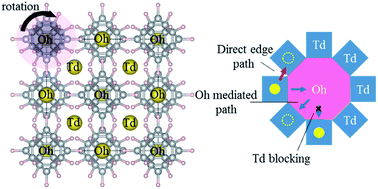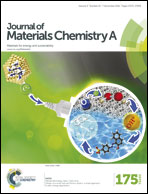Structural origin of the superionic Na conduction in Na2B10H10closo-borates and enhanced conductivity by Na deficiency for high performance solid electrolytes†
Abstract
Recently reported superionic Na closo-borates have drawn considerable attention due to their potential as solid-state electrolytes for Na ion batteries. However, a fundamental understanding of the ion transport mechanism in these materials is still missing. We studied Na conduction in Na2B10H10, a model material, using first-principles calculations. We found that the superior Na diffusivity is closely linked to the behavior of the large B10H102− anionic groups. The reorientations and disorder of these groups facilitate the Na+ hopping to the octahedral (Oh) sites, which link the tetrahedral (Td) sites to form a connected diffusion network. We also found that, in spite of the frequent Na hopping events, the diffusional paths are often blocked, thereby hindering Na transport. Such a mechanism suggests that the Na conductivity can be improved by introducing extrinsic vacancies. By simulating Na-deficient systems, we found that at high temperatures, even a minimal amount of additional Na vacancies significantly increases the ionic diffusivity.


 Please wait while we load your content...
Please wait while we load your content...